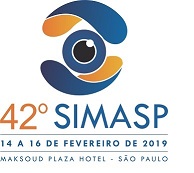Dados do Trabalho
Título
LIMBAL NEOVASCULARIZATION IN GRAFTED CORNEAS EVALUATED BY ANGIOPLEX ® OCT ANGIOGRAPHY
Introdução
The noninvasive image of anterior segment vascularization is still limited to the photograph of the slit lamp. Optical coherence tomography (OCTA) angiography has been widely used in the study of retinal and choroidal vessels, but corneal use is recent. To allow the capture of anterior segment angiography images, adaptations are necessary in the currently available equipment.
Métodos
To evaluate the Anterior Segment Optical Coherence Tomography Angiography to study limbal neovascularization in grafted corneas.
Resultados
Case series including 17 eyes of 12 patients from the Escola Paulista de Medicina - UNIFESP and the Centro Oftalmológico São Paulo. The patients included had a history of corneal transplantation with limbic neovascularization detected by biomicroscopy and were submitted to examination by optical coherence tomography angiography (OCT-A) Images of the four quadrants (nasal, temporal, inferior and superior) of the eye under study were obtained by the Angioplex system of the Cirrus HD-OCT 5000 device (Carl Zeiss, California, USA), with a specific power lens +10.00 adapted, specially developed to allow documentation of corneal neovascularization. The quality of the images in the different quadrants studied as well as the possibility of documentation of the depth of the vessels was analyzed.
Conclusões
Documentation of corneal neovascularization in patients with corneal penetrant keratoplasty with Cirrus Equipment adapted with the +10.00 lens was adequate to accurately delineate vessels without the need for contrast injection or contact.
Palavras Chave
OCTA, keratoplasty, neovascularization, cornea
Arquivos
Área
Miscelânea
Instituições
UNIFESP - São Paulo - Brasil
Autores
ELIMAR MAYARA DE ALMEIDA MENEGOTTO, MICHELLE DE LIMA FARAH, TALITA CRISTINE MIZUSHIMA, ANA LUISA HOFLING-LIMA, CLAUDIO ZETT
